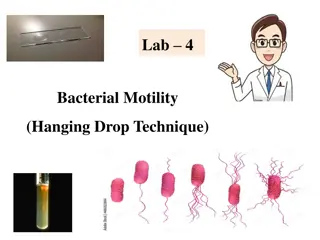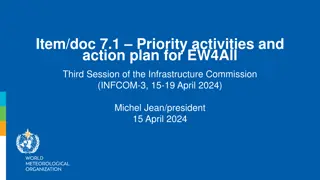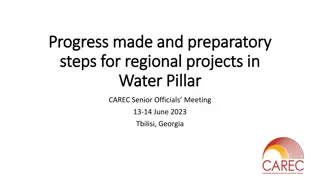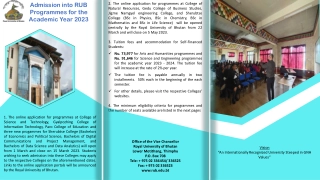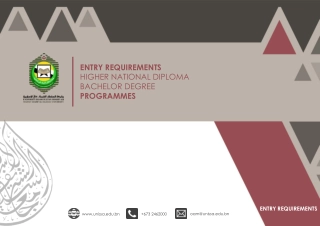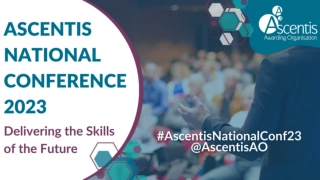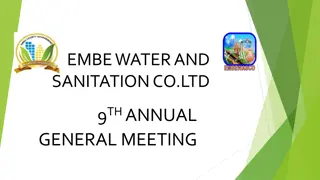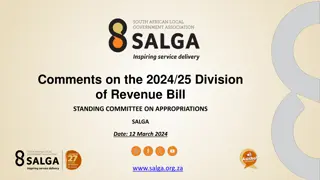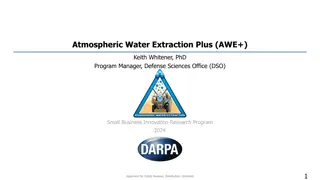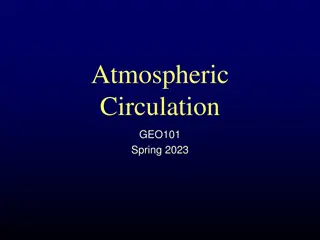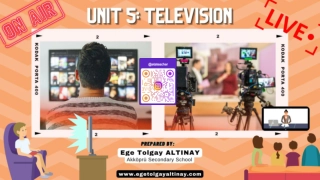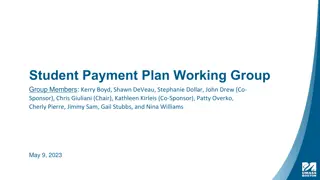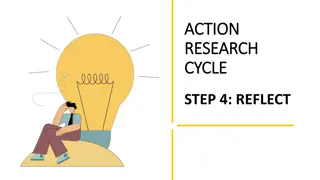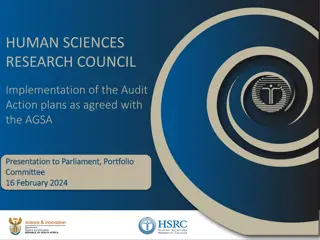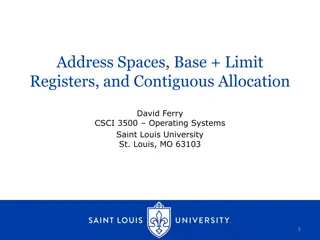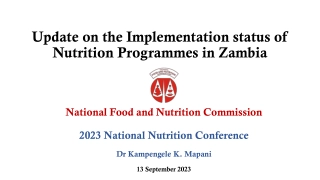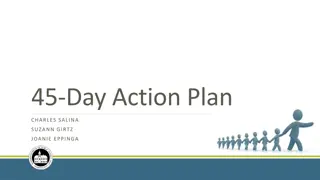Action Plan to Address Poor Performing Municipalities' Water Services Drop Programmes 2023 Results
This presentation outlines key positive and negative results of poor performing municipalities in the 2023 Water Services Drop Programmes. It highlights issues such as infrastructure conditions, staff shortages, non-compliance with water quality regulations, and operational monitoring failures. Key areas needing improvement include drinking water quality compliance, wastewater testing, and advisory notices for systems not meeting standards.
Download Presentation
Please find below an Image/Link to download the presentation.
The content on the website is provided AS IS for your information and personal use only. It may not be sold, licensed, or shared on other websites without obtaining consent from the author. Download presentation by click this link. If you encounter any issues during the download, it is possible that the publisher has removed the file from their server.
Presentation Transcript
Water Services Drop Programmes 2023 Reports: Group 2 Poor Performing Municipalities PRESENTATION TITLE Action plan to address 2023 Blue, Green and No Drop results Facilitated by: Designation: Department: 18 January 2024 Mr. X Zwane DDG: Regulation Compliance and Enforcement DWS Presented by: Designation: Directorate: Name Surname Director Communication Services Date: 15 April 2019 Drinking Water (Blue Drop) Wastewater (Green Drop) Water Conservation and Demand Management (No Drop)
Part A: Summary of key results (1) Introduction This group consist of thirty-eight municipalities that scored poor on average across their water supply systems and/or wastewater supply systems in the 2023 full Blue Drop and 2022 full Green Drop assessments Key Positive Results Across the 38 municipalities, on average 90.3% of the required supervisors posts are filled with properly qualified supervisors (Blue Drop); (61% Green Drop) 72% of the required qualified engineering posts across the 38 municipalities are filled (Blue Drop); (83% Green Drop) Across the 38 municipalities, the average Blue Drop infrastructure condition is 70%. 20 of the 38 municipalities scored average for the Blue Drop infrastructure condition and 13 scored good, 1 of the 38 municipalities was not assessed as it has no Water Treatment Works, and 4 of the 38 scored poor 2
Summary of key results (2) Key Negative Results Across the 38 municipalities, the average Green Drop Infrastructure condition is 49% (poor condition). 19 of the 38 municipalities scored average and 19 had less than average (poor or critical) scores for the condition of the infrastructure 35 of the 38 municipalities had NRW of 30% or higher Across the 38 municipalities, the average %NRW is 51%, with 8 municipalities having % NRW between 50% and 60%, 8 municipalities having a %NRW between 60 % and 70% and 5 having %NRW higher than 70% 31 of the 38 municipalities scored unsatisfactory for operational monitoring (i.e. onsite daily testing) (three do not require this monitoring as they have no Water Treatment Works) Across the 38 municipalities, on average there is 63.4% shortages of the required qualified process controllers (Blue Drop); (47% Green Drop) Shortfall level of qualified scientists is at 70% (Blue Drop); (36% Green Drop) 27 of the 38 municipalities are not able to, or are only partially able to, provide the requested financial information e.g. operations and maintenance budget, capital budget, percentage expenditure on O&M, asset value (Blue Drop) 3
Part A: Summary of key results (3) Key Negative Results continued 35% of the drinking water systems in the 38 municipalities did not achieve acceptable microbiological water quality compliance during the 2021/2022 municipal financial year Of the 38 municipalities, 30 (79%) are failing to conduct the compliance monitoring (daily on-site testing) for wastewater that is required by law Of the 38 municipalities, 35 (92%) are failing to conduct the tests for drinking water required by law 26 municipalities failed to issue advisory notices for 103 drinking water systems which did not meet chemical or microbiological water quality standards during testing in this time period this is against the law 4
PART B: Analysis of results The overall poor performance of most municipalities in this group is mainly due to the poor performance of their wastewater systems The results indicate that municipalities in this group are neglecting their wastewater systems in particular: o The condition of wastewater infrastructure is significantly worse than the condition of drinking water infrastructure The results indicate that the key issue for drinking water systems for this group of municipalities is to address the shortages of process controllers and scientists; whereas the key issue for wastewater systems is to improve the condition of the infrastructure The fact that 72% of engineering/technical posts are filled questions the commonly held view that poor performance is due to an absence of engineers The shortages of certified process controllers and scientists may partially explain the relatively poor performance of this group of municipalities in terms of compliance monitoring i.e. carrying out the required tests, given that generally process controllers are responsible for daily on-site testing The fact that the shortages of process controllers are high but for supervisors are relatively low indicates that this group of municipalities generally needs to put more emphasis on addressing the shortage of qualified process controllers More than 50% of these municipalities have NRW above 50%. It is impossible for a municipality to run the water service function effectively, or to obtain any surplus from the sale of water, if % NRW is 50%, 60% or higher than 70% . It also makes it very difficult for the municipality to budget adequately for operations and maintenance, which cannot be funded from national grants 5
Lessons to be Learned from the Good and Excellent Performing Municipalities Key positive results of the twelve good and excellent performing municipalities Across the twelve municipalities, on average 80% of the required process controller posts are filled with properly qualified process controllers (Blue Drop); (92% Green Drop) Across the twelve municipalities, on average 98% of the required supervisors posts are filled with properly qualified supervisors (Blue Drop); (96% Green Drop) Shortfall levels of qualified scientists and engineers are also extremely low across all the 12 municipalities Of the 12 municipalities, 9 (75%) are regularly carrying out the required tests for drinking water (same for wastewater) These 12 municipalities are able to provide almost all the requested financial information e.g. operations and maintenance budget, capital budget, percentage expenditure on O&M, asset value Across the 12 municipalities, the average Blue Drop infrastructure condition is 85%( 81% for Green Drop). Eleven of the 12 municipalities scored higher than 80% for Blue Drop infrastructure condition (good or excellent- one had infrastructure in an average condition); (8 for Green Drop) Across the 12 municipalities, the average NRW is 29% Across the 12 municipalities there is a 100% excellent compliance with chemical standards for drinking water quality Across the 12 municipalities there is 91% good or excellent compliance with microbiological standards for drinking water 6
Lessons to be learned from the Good and Excellent performing municipalities (2) Analysis of results The results indicate that the best performing municipalities generally: o Have adequate staff with the right qualifications o Keep their infrastructure in a well-maintained condition o Have relatively low NRW, which in turn indicates effective maintenance and management to minimise losses as well as effective billing and revenue collection systems o Have effective compliance and operational monitoring systems, i.e. they carry out required water quality tests and ensure that proper processes are followed o Have effective financial and asset management systems in place and are able to accurately report on their budgets and expenditure and assets 7
PART C: What is to be done Legal Framework Local water supply and sanitation services are a function over which municipalities have executive authority in terms of section 156 of the Constitution read together with Schedule 4 Part B The Water Services Act distinguishes between the roles of the Water Services Authority (WSA) and Water Services Providers (WSPs), and requires the functions to be accounted for separately The Act also states that no entity may function as a WSP without the approval of the relevant WSA The distinction between the WSA function and WSP function is an important one. Only a municipality can be allocated the power and function for the WSA function, o But any legal entity (CBO, NGO, organ of state, private company, municipality, municipal entity, another municipality, or a water board) can be approved by the WSA as a WSP According to the Constitution, local government is obliged to ensure water service provision the primary role of municipalities as WSAs is to take steps to ensure the delivery of water services, not necessarily to deliver the services themselves In terms of the Water Services Act read together with the Municipal Systems Act, a WSA must decide whether to deliver water services itself, or to approve another WSP or WSP s to provide the services Section 76-78 of the Municipal Systems Act require a municipality to engage in defined feasibility study and public consultation processes before deciding to change the mechanism of service delivery between an internal mechanism and an external mechanism 8
Action Plans Each municipality will develop an action plan for improvement, addressing inter alia o Fundamental changes to be introduced, from amongst the options in the following slide o Reducing NRW and leakages o Hiring more process controllers and scientists for drinking water systems in particular o Budgeting adequately for maintenance of wastewater infrastructure o Improving operational monitoring (i.e.. onsite daily testing) o Improving financial management The action plans must include putting in place the required management tools to address poor performance in terms of BD, GD and ND (as described in the guidelines by DWS on the IRIS http://ws.dws.gov.za/iris.aspx ), with timeframe, such as Wastewater Risk Abatement Plans and Process Audits The action plans must be divided into actions with short, medium and long-term timeframes The action plans without substantial financial implications must have short timeframes These action plans must be submitted to the relevant DWS Provincial offices by end February 2024 All municipalities must issue advisory notices without fail when their drinking water quality fails to meet drinking water standards 9
Doing things differently The municipalities in this group are struggling to deliver water and sanitation services which meet the national norms and standards The municipalities in this group need to decide whether they can improve the situation within the existing institutional arrangements or whether a different approach should be considered Within the existing legal frameworks, different approaches to delivering water and sanitation services could include: o Changing the allocation of the WSA function (e.g. reducing the number of WSAs, reallocation of WSA function between Districts and Locals); (allocation of the WSA function is CoGTA s responsibility) o Appointing another municipality to provide the WSP function (e.g. appointing Joburg Water to be the WSP for another LM in Gauteng) o Appointing a water board to be the retail WSP o Creating a special purpose vehicle to be the WSP (e.g. the proposed SPV between Rand water and Emfuleni LM to be the WSP for Emfuleni LM) o Creating a municipal entity (e.g. Joburg Water and ERWAT) o Entering into a long- term concession with the private service provider to be the WSP (e.g. Mbombela LM, Ilembe DM) o Entering into long term service provision contracts for elements of the WSP function (e.g. Overstrand LM and JB Marks LM long term contracts for operations and maintenance of water services infrastructure) o Entering into performance -based contracts to achieve certain goals such as reducing NRW Municipalities in this group should consider the above options for doing things differently and follow the required Municipal Systems Act process if necessary 10
Additional Action Items WSA water safety plans must include identification of potential pollution from upstream WWTW, and consultation with other relevant WSA to address this within 3 months Where appropriate the WSA in this group will engage relevant neighboring WSAs regarding joint catchment risk abatement planning to collectively deal with sewage pollution within 6 months National government to implement its plans to address theft and vandalism and construction mafia - ongoing DWS to plan and implement the required the National Resource infrastructure projects to provide sufficient assurance of supply to municipalities - ongoing WSA to prioritise investment infrastructure and equipment to reduce nonrevenue water (e.g. meters) National government should implement a awareness campaign to address the culture of non-payment over the next 3 months WSA to engage with their communities to address non-payment - ongoing WSA to put in place responsive systems for leak and sewage spills reporting within the next 12 months DWS and COGTA to continue to engage National Treasury with regard to the ringfencing of revenues from the sale of water for the water function WSAs in this group to be mentored by the good performing WSAs (cross-pollination) WSAs to review their Bylaws to enforce revenue collection WSA to focus on upskilling of existing staff with support of training bodies 11
Annexure 1: List of Municipalities for Group 2 1. Chris Hani DM 14. Alfred Nzo DM 27. Emalahleni LM 2. Letsemeng LM 15. Joe Gqabi DM 28. Govan Mbeki LM 3. Nketoana LM 16. O R Tambo DM 29. Thembisile LM 4. Amajuba DM 17. Dihlabeng LM 30. Victor Khanye LM 5. King Cetshwayo DM 18. Mangaung Metro 31. Sol Plaatjie LM 6. Capricorn DM 19. Tswelopele LM 32. Thembelihle LM 7. Greater Sekhukhune DM 20. Emfuleni LM 33. Tsantsabane LM 8. Lephalale LM 21. Ugu DM 34. Madibeng LM 9. Emakhazeni LM 22. uThukela DM 35. Matlosana LM 10. Hantam LM 23. Bela-Bela LM 36. Hessequa LM 11. Siyathemba LM 24. Modimolle-Mookgophong LM 37. Matzikama LM 12. Cederberg LM 25. Mopani DM 38.Oudshoorn LM 13. Laingsburg LM* 26. Dr J S Moroka LM 12



